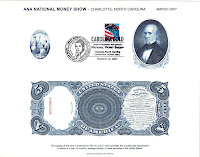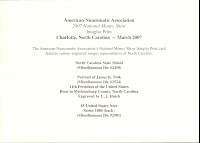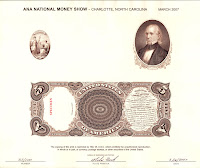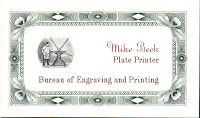Mar 23, 2007 | BEP, shows
 For every show the US Bureau of Engraving and Printing attends, they create special intaglio prints from the original dies in their vaults. BEP selects vignettes significant to the location and the image of one vintage note. For the 2007 ANA National Money Show held in Charlotte, the BEP created a plate that printed cards with the North Carolina State Shield in the upper left (from Miscellaneous Die #2458); portrait of James K. Polk (Miscellaneous Die #2524) 11th President of the United States Born in Mecklenberg County, North Carolina Engraved by L. J. Hatch; and the back of a $5 United States Note Series 1880 (Miscellaneous Die #2981).
For every show the US Bureau of Engraving and Printing attends, they create special intaglio prints from the original dies in their vaults. BEP selects vignettes significant to the location and the image of one vintage note. For the 2007 ANA National Money Show held in Charlotte, the BEP created a plate that printed cards with the North Carolina State Shield in the upper left (from Miscellaneous Die #2458); portrait of James K. Polk (Miscellaneous Die #2524) 11th President of the United States Born in Mecklenberg County, North Carolina Engraved by L. J. Hatch; and the back of a $5 United States Note Series 1880 (Miscellaneous Die #2981).
James Knox Polk, was born on November 2, 1795, in an area of Mecklenburg County that is part of Pineville today. Pineville is a bustling suburb of to the southwest of Charlotte. Polk is the only former Speaker of the House to become President and was governor of Tennessee at the time of his election in 1844.
 BEP offered this print for $20 at the show. Today, you can purchase it from the BEP online store for $22.50. The one pictured here was purchased at the show then taken to the USPS booth where I purchased a 39-cent stamp and was postmarked with a special stamp made for the show. Having it postmarked on the first day of issue is nice.
BEP offered this print for $20 at the show. Today, you can purchase it from the BEP online store for $22.50. The one pictured here was purchased at the show then taken to the USPS booth where I purchased a 39-cent stamp and was postmarked with a special stamp made for the show. Having it postmarked on the first day of issue is nice.
 BEP was offering a limited edition of 100 intaglio prints made at the show that was autographed by the printer on site. In order to win, you had to write you name on a piece of paper and put it in a bowl. When they drew the names, you had to be there to claim the print. After watching the demonstration and listening to the discussions, I put my name into the bowl and waited for the 4pm drawing. After 16 were claimed and many were disqualified for not being present, my name was picked from the bowl. This gave me the ability to purchase print number 37.
BEP was offering a limited edition of 100 intaglio prints made at the show that was autographed by the printer on site. In order to win, you had to write you name on a piece of paper and put it in a bowl. When they drew the names, you had to be there to claim the print. After watching the demonstration and listening to the discussions, I put my name into the bowl and waited for the 4pm drawing. After 16 were claimed and many were disqualified for not being present, my name was picked from the bowl. This gave me the ability to purchase print number 37.
 Included with both prints is a card explaining the images on the intaglio print and the limited edition intaglio print included a card from the printer.
Included with both prints is a card explaining the images on the intaglio print and the limited edition intaglio print included a card from the printer.
Click on the images to enlarge.
Apr 8, 2006 | BEP, coins, currency
Money has always been a fascination because of their design and the history they reveal. It is interesting to look at a series of the same denomination and learn the history behind the designs. I had the chance to do that when my bank’s ATM gave me three generations of $20 Federal Reserve Notes (FRN). Although I am not a bank note collector, I find their images and devices interesting.
 First, I found is the Series 1990 note with the signature of Treasury Secretary Nicholas F. Brady and Catalina Vasquez Villalpando, the Treasurer of the United States. Both Brady and Villalpando were appointed by President George H. W. Bush and served until the end of his term. Brady also served for six months under President Ronald W. Reagan.
First, I found is the Series 1990 note with the signature of Treasury Secretary Nicholas F. Brady and Catalina Vasquez Villalpando, the Treasurer of the United States. Both Brady and Villalpando were appointed by President George H. W. Bush and served until the end of his term. Brady also served for six months under President Ronald W. Reagan.
The second is a Series 2001 note with the signatures of Treasury Secretary Paul M. O’Neill and Treasurer Rosario Marin. They were appointed by President George W. Bush during his first term. The third note is from Series 2004 with Marin’s signature along with Treasury Secretary John W. Snow, who succeeded O’Neill.
 My first impression was the differences in design. The $20 FRN was first designed in the 1920s and was an evolution of earlier designs. It has ornate and fine engraving with a green hue. The fine engraving has been a staple of bank notes since their inception as a means to prevent counterfeiting. The “green back” was used to prevent copying using new photographic technologies which had a difficult time reproducing the green color. Today, the green color remains out of tradition considering modern imaging capabilities.
My first impression was the differences in design. The $20 FRN was first designed in the 1920s and was an evolution of earlier designs. It has ornate and fine engraving with a green hue. The fine engraving has been a staple of bank notes since their inception as a means to prevent counterfeiting. The “green back” was used to prevent copying using new photographic technologies which had a difficult time reproducing the green color. Today, the green color remains out of tradition considering modern imaging capabilities.
The newer notes do not have a lot of fine engraving. The same portrait of President Andrew Jackson is used but was enlarged on the newer notes with the border around the portrait removed on the Series 2004 notes. Another difference is the addition of color with a darker green hue and peach on the front adds a new dimension I am not sure I like.
Although an engraving of the White House remain on the reverse, the older note uses an image taking from the south lawn from the ellipse. The new notes show the White House from the north lawn that could be seen from Pennsylvania Avenue more centered rather than filling the entire reverse. As part of the Bureau Engraving and Printing’s (BEP) program to include better security features, they have left the sides blank so the watermark image and security thread can be easily seen.
I like the front of the latest note, but I don’t like the color. I also miss the indication of the Federal Reserve System Bank for which the notes were printed. It is like the mint mark for the FRN. I always found it interesting finding notes from different areas. I like the south lawn portrait better than the one from the north lawn. I am disappointed with the starkness of the reverse. I am not sure that BEP can change this given the nature of the security features.
Finally, the attempt to colorize the notes is not working. It looks cheesy. If BEP colorizes the note, it should be more than just a gradient on the background. Many countries use color in their bank notes as part of the devices, not just to splash some color around to say “look at the color.” I think BEP can do better.
 For every show the US Bureau of Engraving and Printing attends, they create special intaglio prints from the original dies in their vaults. BEP selects vignettes significant to the location and the image of one vintage note. For the 2007 ANA National Money Show held in Charlotte, the BEP created a plate that printed cards with the North Carolina State Shield in the upper left (from Miscellaneous Die #2458); portrait of James K. Polk (Miscellaneous Die #2524) 11th President of the United States Born in Mecklenberg County, North Carolina Engraved by L. J. Hatch; and the back of a $5 United States Note Series 1880 (Miscellaneous Die #2981).
For every show the US Bureau of Engraving and Printing attends, they create special intaglio prints from the original dies in their vaults. BEP selects vignettes significant to the location and the image of one vintage note. For the 2007 ANA National Money Show held in Charlotte, the BEP created a plate that printed cards with the North Carolina State Shield in the upper left (from Miscellaneous Die #2458); portrait of James K. Polk (Miscellaneous Die #2524) 11th President of the United States Born in Mecklenberg County, North Carolina Engraved by L. J. Hatch; and the back of a $5 United States Note Series 1880 (Miscellaneous Die #2981). BEP offered this print for $20 at the show. Today, you can purchase it from the BEP online store for $22.50. The one pictured here was purchased at the show then taken to the USPS booth where I purchased a 39-cent stamp and was postmarked with a special stamp made for the show. Having it postmarked on the first day of issue is nice.
BEP offered this print for $20 at the show. Today, you can purchase it from the BEP online store for $22.50. The one pictured here was purchased at the show then taken to the USPS booth where I purchased a 39-cent stamp and was postmarked with a special stamp made for the show. Having it postmarked on the first day of issue is nice. BEP was offering a limited edition of 100 intaglio prints made at the show that was autographed by the printer on site. In order to win, you had to write you name on a piece of paper and put it in a bowl. When they drew the names, you had to be there to claim the print. After watching the demonstration and listening to the discussions, I put my name into the bowl and waited for the 4pm drawing. After 16 were claimed and many were disqualified for not being present, my name was picked from the bowl. This gave me the ability to purchase print number 37.
BEP was offering a limited edition of 100 intaglio prints made at the show that was autographed by the printer on site. In order to win, you had to write you name on a piece of paper and put it in a bowl. When they drew the names, you had to be there to claim the print. After watching the demonstration and listening to the discussions, I put my name into the bowl and waited for the 4pm drawing. After 16 were claimed and many were disqualified for not being present, my name was picked from the bowl. This gave me the ability to purchase print number 37. Included with both prints is a card explaining the images on the intaglio print and the limited edition intaglio print included a card from the printer.
Included with both prints is a card explaining the images on the intaglio print and the limited edition intaglio print included a card from the printer.

